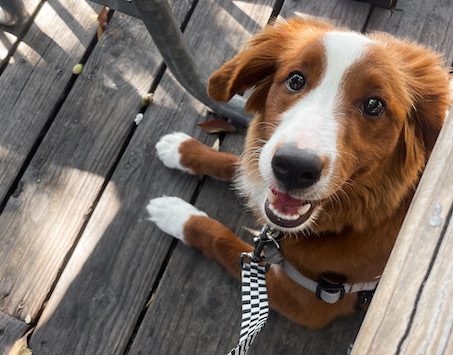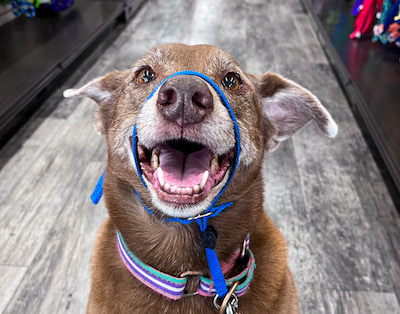Do you want an easy command to teach your puppy that is also useful in everyday life? The “down” command is a fan favorite! Once learned and managed correctly, puppies can hold this command for up 30 minutes to an hour or longer! This command is a good tool to use when you are eating, watching TV, sitting on a park bench, and so much more!

Supplies
A few things you will need to start teaching your puppy down are as follows:
- A treat bag
- Kibble or high-value treats
- Collar (we recommend a Martingale or buckle collar)
- Leash
- 15ft or 50ft long line
Where to start
Using a lure
- Put your puppy’s properly fitted collar on and attach a 5-6ft leash to it.
- Place a piece of kibble or a high-value treat in between your index finger and thumb. Put your hand in front of your puppy’s nose, so the food is visible to them.
- If they are sitting, slowly lower your hand to the ground. Once your hand is on the ground, slowly move your hand closer to you. Your puppy should slide from a sitting position into a down position.
- If your puppy is standing, slowly lower your hand to the ground. Once your hand is on the ground, move your hand in between your puppy’s paws towards their chest.
- Once your puppy’s elbows and bottom are on the ground, whether they start in a standing or sitting position, say the bridge word we use to create a one-to-one ratio with food, which is “good.” After saying “good” give your puppy the piece of kibble or a treat.
- Toss a piece of kibble 2-3 feet away from your puppy so they get up and you can practice again!
- Repeat steps 2 through 4, 10-15 times successfully before moving forward.
Using a hand signal
- Once your puppy is easily going into a down position with you holding a treat or piece of kibble in your hand, keep the same rhythm and start using a hand signal. We recommend a flat palm to the ground.
- Bridge “good” and feed them once their elbows and bottom are on the ground. Toss a piece of food away from you or encourage them to get up in order to continue practicing.
- If at any point your puppy struggles with the new difficulty level, take a step back and practice the previous steps again before moving on.
Introducing the verbal command
- As your puppy becomes reliable with you signaling them into a down position without food in your hand, start saying “‘Your puppy’s name,’ down.” If after a few seconds, your puppy does not comply with the verbal command use the hand signal.
- When your puppy’s elbows touch the ground, bridge “good” and feed your puppy a treat. Release your puppy from the command by saying “Your puppy’s name, free.” Repeat.

The Three D’s
Once your puppy successfully complies with the verbal command, you can start introducing the three D’s of training, distance, duration, and distractions!
Distance
- Attach the 15 or 50ft long line to your puppy. Start creating distance from them or if your puppy will not stay a few feet from you, tether them to something sturdy (i.e. kitchen table, couch, door, tree, etc.)
- Start off slow, by standing 5 feet away from your puppy. Say “Your puppy’s name, down” if they comply with the command bridge “good” when both of their elbows and bottom are on the ground and give them a treat.
- If your puppy doesn’t go down at first use an exaggerated hand signal to get them into the down position.
- As your puppy becomes more successful and confident, start creating more distance from them and eventually working your way up to the full 15 or 50 ft of the long line!
Duration
- As your puppy progresses, have your puppy hold the “down” command for longer periods of time. To set your puppy up for success, bridge “good” and feed your puppy every few seconds at first and then decrease the amount of time between bridging “good” and feeding as your puppy becomes more reliable at holding the position.
- Depending on your puppy’s level of excitement, some puppies might need to be bridged “good” and treated more frequently than others. Don’t be discouraged, if initially, you need to bridge and feed continuously in order for your puppy to be successful.
- As you continue to practice you can eventually work your way up to 30 minutes to an hour if you are consistent!
Distractions
- Start increasing the difficulty when prompting the verbal command. Practice the command in the presence of other dogs, people, on walks, at the park, on concrete, in the grass, etc!
Helpful Tip
Only increase one of the three D’s of training at a time, to set your puppy up for success. Increasing too many components at once can be overly challenging. Keep in mind when introducing any new component to the command, always take a few steps back, by initially starting with food in your hand, using the hand signal, and then only using the verbal command. This will allow you and your puppy to be successful and minimize your frustration if your puppy doesn’t comply with the command the first time in a new environment! Training takes time, patience, and consistency!
Troubleshooting
- If your puppy is a toy breed, start by kneeling or sitting on the floor, and then stand up as luring them into a down becomes more effortless.
- If your puppy is struggling on a slippery surface, move them to a rougher surface, such as a carpet.
- Once your puppy has the down command using a verbal command, be conscious of your hand placement. Keep your hands lowered at your sides in a neutral position, so your puppy does not get confused.
Good luck with training! If you need additional help or would like to advance to the next level, we offer personalized obedience training programs to achieve your training goals.




